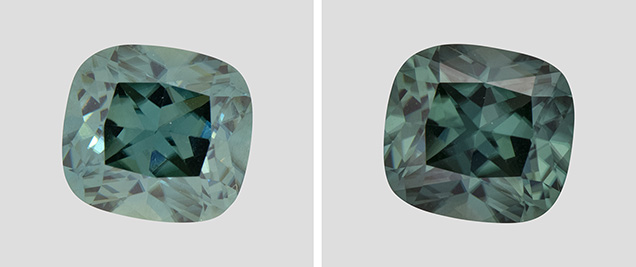Zircon with Unusual Color-Change Behavior

The Carlsbad laboratory recently had the chance to examine a 4.60 ct cushion-cut zircon with truly unusual color behavior. Standard gemological testing confirmed that the stone’s properties were consistent with zircon: an over-the-limit RI, an SG of 4.72, weak yellow fluorescence in short-wave UV and no fluorescence in long-wave UV, and a typical uranium-related pattern in the spectroscope with a prominent sharp peak at 653 nm. The zircon’s color was green using a standard white light fluorescent illuminant with a color temperature of 5500 K (figure 1).


The stone’s color was also checked using a standard incandescent illuminant, but there was no discernible difference from the cool fluorescent illuminant (table 1). However, the color of the zircon was markedly different using white light LEDs with variable color temperature from 2700 K (warm) to 6500 K (cool), where the color went from grayish purple in cool LED light to green in warm LED light (figure 2). Notably, the color observed in the cool LED light was quite similar to the color seen when the stone was taken outside and observed in diffused daylight.

The discrepancy between the colors seen using the cool fluorescent illuminant (green) and either daylight or the cool LED illuminant (grayish purple) can be understood by studying the absorption spectrum of the zircon compared to the emission spectrum of the cool fluorescent bulb (figure 3). The perception of cool white light output from the fluorescent bulb is achieved with two relatively sharp emission bands at about 435 nm and 545 nm, which is in contrast to the much smoother broad-band emission pattern of true daylight. One of the sharp emission bands in the fluorescent illuminant overlaps significantly with sharp absorption bands in the zircon at 424 and 433 nm. The fact that a significant portion of the blue emission from the fluorescent bulb is selectively absorbed by the zircon skews its color away from the blue color that ought to be observed in true daylight. This blue can also be observed using cool LEDs, which tend to have smoother broad emission patterns more closely resembling black-body radiation patterns of true daylight and incandescent light. This unusual color-change behavior is only expected in gems with sharp absorption bands, likely related to either rare earth or actinide elements. Of particular note, these color-change zircons are occasionally recovered from the gem mining areas around Mogok, Myanmar. For these gems, LEDs should provide a more reliable color grading illumination environment than fluorescent light sources.



